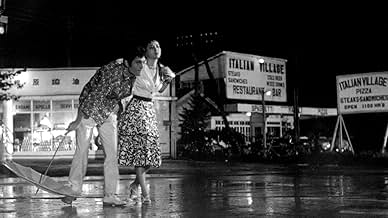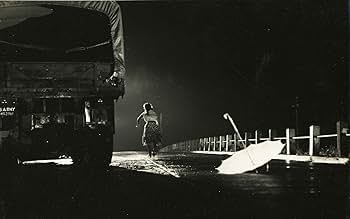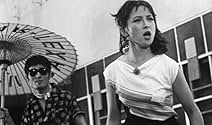IMDb RATING
7.2/10
1.3K
YOUR RATING
A love triangle develops between a benevolent student, his innocent girlfriend, and a cruel petty criminal, all as a point of diagnosis of a social disease that had Japan slowly succumbing t... Read allA love triangle develops between a benevolent student, his innocent girlfriend, and a cruel petty criminal, all as a point of diagnosis of a social disease that had Japan slowly succumbing to lawlessness during the post-War era.A love triangle develops between a benevolent student, his innocent girlfriend, and a cruel petty criminal, all as a point of diagnosis of a social disease that had Japan slowly succumbing to lawlessness during the post-War era.
- Director
- Writers
- Stars
- Director
- Writers
- All cast & crew
- Production, box office & more at IMDbPro
Featured reviews
From that beautiful classic rumble like music they blare frequently, to the cast sporting unique bright clothing in high contrast to the dark or black backgrounds that often inhabit the screen, the look and feel of this film is true noir, fantastic cinematography, and a dark themed plot.
Complete with romance, gang violence, a slumbers handing out evictions, and a love triangle. . Id call the plot original. And enthralling, in plain terms.
I put this up against classics like M, Chinatown, the Crimson Kimono.
Complete with romance, gang violence, a slumbers handing out evictions, and a love triangle. . Id call the plot original. And enthralling, in plain terms.
I put this up against classics like M, Chinatown, the Crimson Kimono.
Japanese drama from Shochiku and director Masaki Kobayashi. The story follows civil engineering student Nishida (Fumio Watanabe) as he moves into a slum apartment building near a U. S. army base. His fellow tenants struggle to survive by doing all sorts of unsavory things, while Nishida simply tries to keep his head down, concentrating on his studies, and staying out of trouble. Things get complicated when he falls for nice-girl waitress Shizuko (Ineko Arima), who has also caught the eye of young gang leader Killer Joe (Tatsuya Nakadai).
Director Kobayashi's film is meant as an indictment on post-war Japanese decadence and corruption, with a very critical eye toward the continuing U. S. military presence. Various concessions made for the comfort and convenience of the troops lead to poverty and squalor for the neighboring Japanese citizens, many of whom turn to petty crime and prostitution for survival. I think the director's message gets lost a bit in the love triangle, though. Watanabe makes for a passable lead, while Arima turns in another good turn, although not as impressive as that in Tokyo Twilight, which I watched yesterday. The real star is Nakadai, one of my favorite Japanese actors, here in his breakthrough role. He's menacing and compelling, while also imbuing what could have been a one-note psycho-thug with some depth and nuance. The film features excellent, moody cinematography, and the oppressive heat of the summer season is depicted very well.
Director Kobayashi's film is meant as an indictment on post-war Japanese decadence and corruption, with a very critical eye toward the continuing U. S. military presence. Various concessions made for the comfort and convenience of the troops lead to poverty and squalor for the neighboring Japanese citizens, many of whom turn to petty crime and prostitution for survival. I think the director's message gets lost a bit in the love triangle, though. Watanabe makes for a passable lead, while Arima turns in another good turn, although not as impressive as that in Tokyo Twilight, which I watched yesterday. The real star is Nakadai, one of my favorite Japanese actors, here in his breakthrough role. He's menacing and compelling, while also imbuing what could have been a one-note psycho-thug with some depth and nuance. The film features excellent, moody cinematography, and the oppressive heat of the summer season is depicted very well.
Another masterpiece by Masaki Kobayashi which might not be the likes of "Human Condition Trilogy", "Hara-kari", "kwaidan" but still is among one of his very strong works.
Could be considered an early Kobayashi film, which should recieve more recognition, but imdb votes tell the story that its reach to the audience has not been that great.
It is like the Combination of Kurosawa's "The lower Depths, (1957) and Mizoguchi's" Street of Shame" but in a good way giving proper homages.
The characters ; like the surroundings are all Stinky and dirty, all selfish and thinking about only themselves, where even close relations are not that close but money minded.
A student and an Innocent girl are also not left untouched by this dirt which even deterioration their their character to do immoral deeds.
The Atmosphere and the music makes great collaboration along with camerawork to show the traits of characters, be it good or evil intent.
Tatsuya Nakadai does a great job as an thug and yakuza man, and so does Ineko Arima( the Ozu girl, "Tokyo Twilight", "Equinox Flower") as an innocent girl turning immoral to keep up with the Stinky Atmosphere of her New surroundings.
A good Kobayashi film that needs more reach and recognition.
A good Kobayashi film that needs more reach and recognition.
"Kuroi kawa" ("Black River") is a most unusual Japanese film. While most films from this era tell stories about love or samurai warriors from the past, this one is planted firmly in post-war Japan...and among the lowest classes of society. Instead of showing nice folks, most people in the film are of the dregs...prostitutes, pimps, voyeurs, thugs and the like. And, for the most part, these people are incredibly ugly...not just spiritually but physically as well. It seems that director Masaki Kobayashi wanted to expose this ugliness...and the film is indeed an indictment of this. And, I am pretty sure Japanese audiences must have been shocked to see this!
The story is set in an incredibly seedy rooming house near a US military base. Most of the residents seem like degenerates and yet, oddly, a seemingly nice engineering student decides to live among them in order, he claims, to save money. It's hard to believe anyone living there who has any other options. He is interested in a lady who works as a waitress but before they can develop a relationship, she is kidnapped and raped by a creep they nickname 'Joe the Killer'! Now, she's stuck in a relationship with Joe...as he refuses to let her go, as she is now his 'property'. And, so she is hoping, somehow, the student will be able to rescue her from her plight with this violent brute.
If you are looking for a nice film or one that leaves you happy, then by all means do NOT watch this movie. Now it's not a bad film....but it is a bit depressing and sad to watch. After all, it's about the writer's perceptions about he breakdown of the social fabric in Japan. Interesting, very well crafted...and, at times, hard to watch.
The story is set in an incredibly seedy rooming house near a US military base. Most of the residents seem like degenerates and yet, oddly, a seemingly nice engineering student decides to live among them in order, he claims, to save money. It's hard to believe anyone living there who has any other options. He is interested in a lady who works as a waitress but before they can develop a relationship, she is kidnapped and raped by a creep they nickname 'Joe the Killer'! Now, she's stuck in a relationship with Joe...as he refuses to let her go, as she is now his 'property'. And, so she is hoping, somehow, the student will be able to rescue her from her plight with this violent brute.
If you are looking for a nice film or one that leaves you happy, then by all means do NOT watch this movie. Now it's not a bad film....but it is a bit depressing and sad to watch. After all, it's about the writer's perceptions about he breakdown of the social fabric in Japan. Interesting, very well crafted...and, at times, hard to watch.
Although Masaki Kobayashi belongs to the generation after Yasujiro Ozu, he is in particular known for his triloogy about Japan during the Second World War ("The human condition" 1959 - 1961), while Ozu portrays the Japanese middle class during the years after Worldwar II. In this somewhat lesser known film Kobayashi focusses also on the postwar years. His subject is however not the middle class but people on the fringes of society. In this respect the film is more like a Mizoguchi film than like an Ozu film.
The story seems to be about a girl who has to choose between a poor student (the good guy) and a petty criminal who can afford to offer her more luxury (the bad guy). In reality the story is however much broader than this. We meet the inhabitants of an appartment complex nearby an American army compound (one of which is the aforementioned poor student). The landlord tries to throw them out of their houses so she can start a brothel. Althoug the story of the student and the the girl is predominant, we also learn something about the other inhabitants. The film takes on some elements of the ensemble film and can be compared with "Street of shame" (1956, Kenji Mizoguchi).
The image that Kobayashi presents of the Japanese society is not a favourable one. The American occupiers do not have a positive influence. On numerous occasions a jet fighter is flying over causing an immense roar, just to make clear how annoying the presence of American soldiers realy is. The question is how fair this kind of framing is. To be sure the American soldiers without any doubt are responsible for the demand for prostitutes. The supply of these prostitutes and the real estate corruption that surrounds the establishment of the brothel are however of a Japanese making.
The story seems to be about a girl who has to choose between a poor student (the good guy) and a petty criminal who can afford to offer her more luxury (the bad guy). In reality the story is however much broader than this. We meet the inhabitants of an appartment complex nearby an American army compound (one of which is the aforementioned poor student). The landlord tries to throw them out of their houses so she can start a brothel. Althoug the story of the student and the the girl is predominant, we also learn something about the other inhabitants. The film takes on some elements of the ensemble film and can be compared with "Street of shame" (1956, Kenji Mizoguchi).
The image that Kobayashi presents of the Japanese society is not a favourable one. The American occupiers do not have a positive influence. On numerous occasions a jet fighter is flying over causing an immense roar, just to make clear how annoying the presence of American soldiers realy is. The question is how fair this kind of framing is. To be sure the American soldiers without any doubt are responsible for the demand for prostitutes. The supply of these prostitutes and the real estate corruption that surrounds the establishment of the brothel are however of a Japanese making.
Did you know
- TriviaTatsuya Nakadai's first major role for director Kobayashi, starting a partnership that lasted over 15 years and 10 films.
- ConnectionsReferences Neptune's Daughter (1949)
- How long is Black River?Powered by Alexa
Details
- Runtime1 hour 54 minutes
- Color
- Sound mix
- Aspect ratio
- 1.37 : 1
Contribute to this page
Suggest an edit or add missing content



























